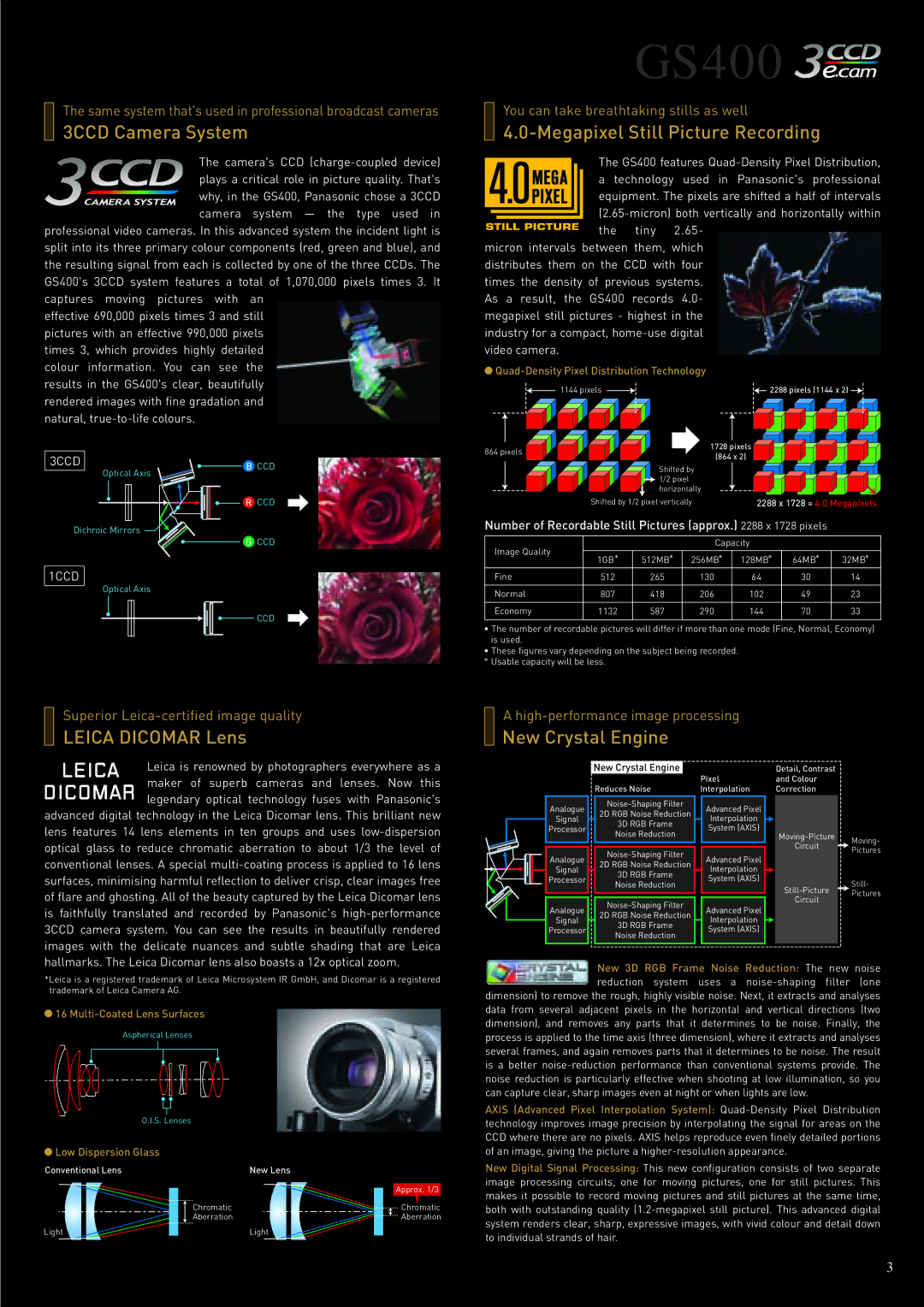
The same system that's used in professional broadcast cameras
3CCD Camera System
The camera's CCD
professional video cameras. In this advanced system the incident light is split into its three primary colour components (red, green and blue), and the resulting signal from each is collected by one of the three CCDs. The GS400's 3CCD system features a total of 1,070,000 pixels times 3. It captures moving pictures with an
effective 690,000 pixels times 3 and still pictures with an effective 990,000 pixels times 3, which provides highly detailed colour information. You can see the results in the GS400's clear, beautifully rendered images with fine gradation and natural,
3CCD | B CCD |
| Optical Axis |
R CCD
Dichroic Mirrors
G CCD
1CCD
Optical Axis
CCD
GS400 



You can take breathtaking stills as well
4.0-Megapixel Still Picture Recording
The GS400 features
![]()
![]()
![]()
![]()
![]()
![]()
![]() the tiny 2.65- micron intervals between them, which distributes them on the CCD with four times the density of previous systems. As a result, the GS400 records 4.0- megapixel still pictures - highest in the industry for a compact,
the tiny 2.65- micron intervals between them, which distributes them on the CCD with four times the density of previous systems. As a result, the GS400 records 4.0- megapixel still pictures - highest in the industry for a compact,
•Quad-Density Pixel Distribution Technology
| 1144 pixels |
|
| 2288 pixels (1144 x 2) | |||
864 pixels |
|
| 1728 pixels |
|
| ||
|
| (864 x 2) |
|
| |||
|
|
|
|
| |||
|
| Shifted by |
|
|
| ||
|
| 1/2 pixel |
|
|
|
| |
|
| horizontally |
|
|
| ||
| Shifted by 1/2 pixel vertically | 2288 x 1728 = 4.0 Megapixels | |||||
Number of Recordable Still Pictures (approx.) 2288 x 1728 pixels |
| ||||||
Image Quality |
|
| Capacity |
|
| ||
1GB* | 512MB* | 256MB* | 128MB* | 64MB* | 32MB* | ||
| |||||||
Fine | 512 | 265 | 130 | 64 | 30 | 14 | |
Normal | 807 | 418 | 206 | 102 | 49 | 23 | |
Economy | 1132 | 587 | 290 | 144 | 70 | 33 | |
•The number of recordable pictures will differ if more than one mode (Fine, Normal, Economy) is used.
•These figures vary depending on the subject being recorded.
* Usable capacity will be less.
Superior
LEICA DICOMAR Lens
A
New Crystal Engine
Leica is renowned by photographers everywhere as a maker of superb cameras and lenses. Now this legendary optical technology fuses with Panasonic's
advanced digital technology in the Leica Dicomar lens. This brilliant new lens features 14 lens elements in ten groups and uses
Analogue
Signal
Processor
Analogue
Signal
Processor
Analogue
Signal
Processor
New Crystal Engine |
| Detail, Contrast |
|
| Pixel | and Colour |
|
Reduces Noise | Interpolation | Correction |
|
Advanced Pixel |
|
| |
2D RGB Noise Reduction |
|
| |
Interpolation |
|
| |
3D RGB Frame |
|
| |
System (AXIS) |
|
| |
Noise Reduction |
| ||
| Moving- | ||
|
| Circuit | |
| Pictures | ||
Advanced Pixel |
| ||
|
| ||
2D RGB Noise Reduction |
|
| |
Interpolation |
|
| |
3D RGB Frame |
|
| |
System (AXIS) |
| Still- | |
Noise Reduction |
| ||
| |||
|
| Pictures | |
|
| Circuit | |
|
| ||
Advanced Pixel |
|
| |
2D RGB Noise Reduction |
|
| |
Interpolation |
|
| |
3D RGB Frame |
|
| |
System (AXIS) |
|
| |
Noise Reduction |
|
| |
|
|
|
*Leica is a registered trademark of Leica Microsystem IR GmbH, and Dicomar is a registered trademark of Leica Camera AG.
•16
Aspherical Lenses
O.I.S. Lenses
•Low Dispersion Glass
Conventional Lens | New Lens |
| Approx. 1/3 |
Chromatic | Chromatic |
Aberration | Aberration |
Light | Light |
New 3D RGB Frame Noise Reduction: The new noise reduction system uses a
data from several adjacent pixels in the horizontal and vertical directions (two dimension), and removes any parts that it determines to be noise. Finally, the process is applied to the time axis (three dimension), where it extracts and analyses several frames, and again removes parts that it determines to be noise. The result is a better
AXIS (Advanced Pixel Interpolation System):
New Digital Signal Processing: This new configuration consists of two separate image processing circuits, one for moving pictures, one for still pictures. This makes it possible to record moving pictures and still pictures at the same time, both with outstanding quality
3
